We have a strict honesty policy, but please note that when you buy through our links, we may earn a commission. Learn more.
In this Printify review, I’m going to walk you through the pros and cons of one of the best-known print-on-demand apps on the market. Is it right for you, or should you try another platform?
Let’s start things off with a key question…
What is Printify?
Printify is a leading print-on-demand (POD) service that lets you design, print and sell custom products via your own ecommerce store or by listing them on online marketplaces like Etsy, eBay and Walmart.
The platform lets you add your own brand or designs to over 1,000 printable products, all of which can be customized in an easy-to-use product designer.
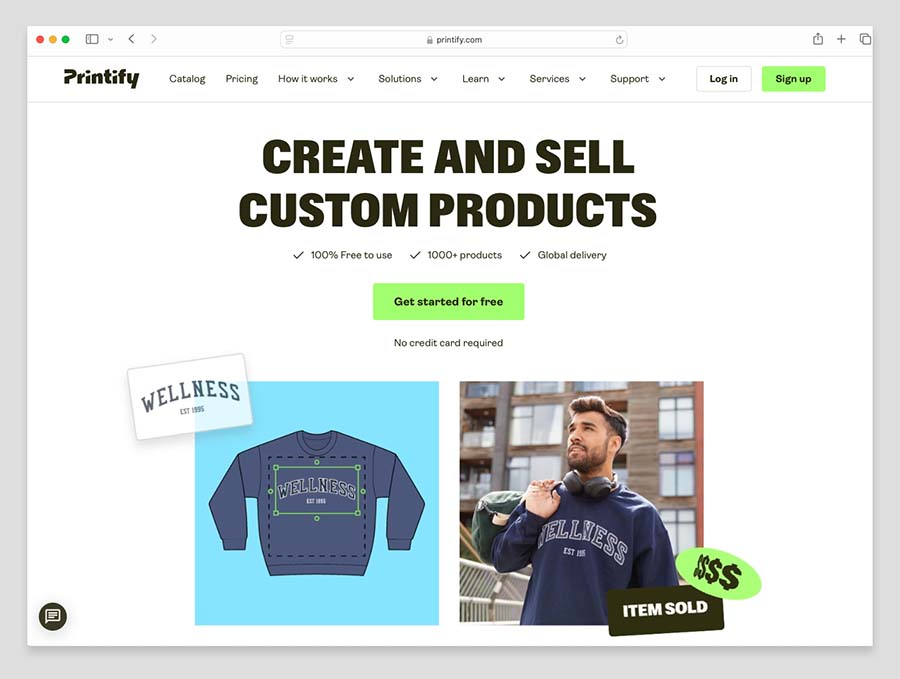
In addition to handling the printing of your products, Printify also takes care of all aspects of product fulfillment for you too — by packaging up your products and shipping them to your customer for you.
But Printify differs from most other POD services in one key respect: it lets you choose who prints your product. You can work with any of its 80+ print providers in the Printify print provider network (located across 100+ locations on 4 continents).
(Other POD services tend to print your products in-house or assign a third party printer on your behalf.)
So Printify gives you, the POD merchant, quite a lot of choice in terms of product pricing, production processes, fulfillment services and shipping times.
How many people use Printify?
Printify was founded by a trio of Latvian business people, Artis Kehris, Gatis Dukurs, and James Berdigans, in 2015.
The company now has around 650 employees and is currently valued at $300 million. Printify counts Index Ventures, H&M Group, Virgin Group, Squarespace, and Will Smith’s Dreamers VC among its many investors and backers.
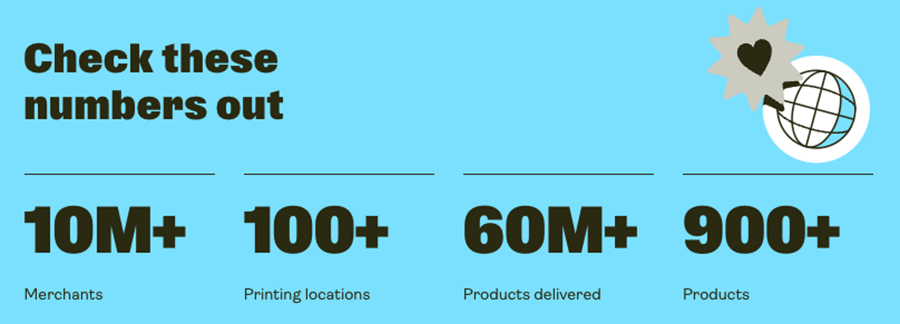
During the ten years since its launch, Printify has been used by over 10 million merchants, and to date it has sold over half a billion dollars worth of products.
How Printify works
To start a successful print-on-demand business, you need products, a way to sell them (like an online store or marketplace), and a service to handle fulfillment.
Printify lets you meet these requirements via 4 key steps. You…
- Choose a Printify product to customize.
- Select a print provider.
- Design your product.
- Add your products to an online store or ecommerce marketplace.
Let’s look at the product end of things.
Printify’s product range
Printify boasts one of the largest product catalogs of all the big-name print on demand platforms — a product range comprising over 1,000 items is available.
This is more than double the size of the product range offered by the platform’s biggest competitor, Printful — and several times bigger than the ranges offered by other competing POD companies like Spring, Spreadshirt and SPOD.
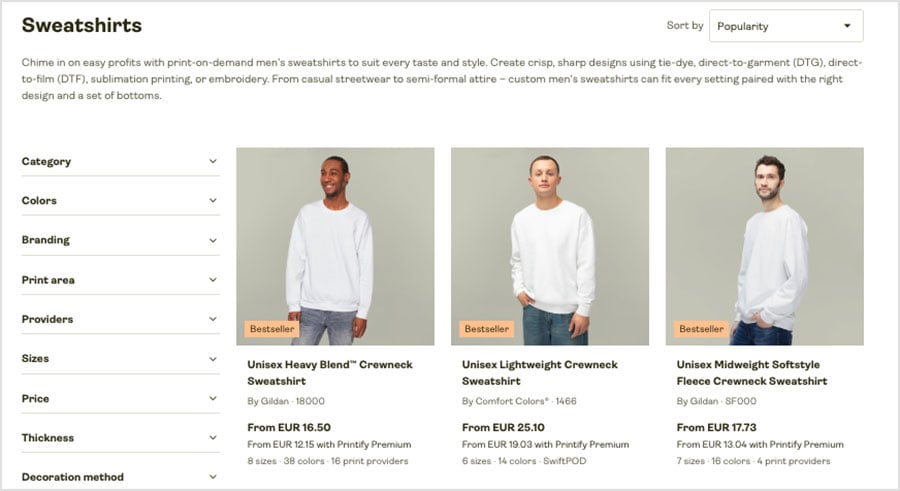
This huge catalog is largely the result of Printify working with so many print providers. Several of these specialize in non-standard printing techniques, and this allows Printify to offer more types of products than other POD platforms (who are more restricted by the printing capabilities of their in-house production facilities or smaller print provider networks).
Printify’s product range is broken down into 6 main categories:
- Men’s clothing — 170+ products including t-shirts, hoodies, sweatshirts, tank tops, sportswear, bottoms and shoes.
- Women’s clothing — 210+ products including skirts and dresses, t-shirts, hoodies, sweatshirts, tank tops, sportswear, bottoms and shoes.
- Kids’ clothing — 55+ products including baby clothing, t-shirts, sweatshirts and bottoms.
- Accessories — 240+ products including face masks, phone cases, bags, tech accessories, stationery, jewelry and kitchenware.
- Home & Living — 370+ products including drink ware, posters, notebooks, towels, rugs, seasonal decorations and ornaments.
- Food – Health – Beauty — 50+ products including coffee, dietary supplements and beauty creams.
In most product categories, you’ll almost always find that Printify’s offering eclipses its competitors’ equivalent ranges.
Taking the key POD category of t-shirts as an example, Printify gives you the option to sell 170 different t-shirts — three times the number available from SPOD or Printful.
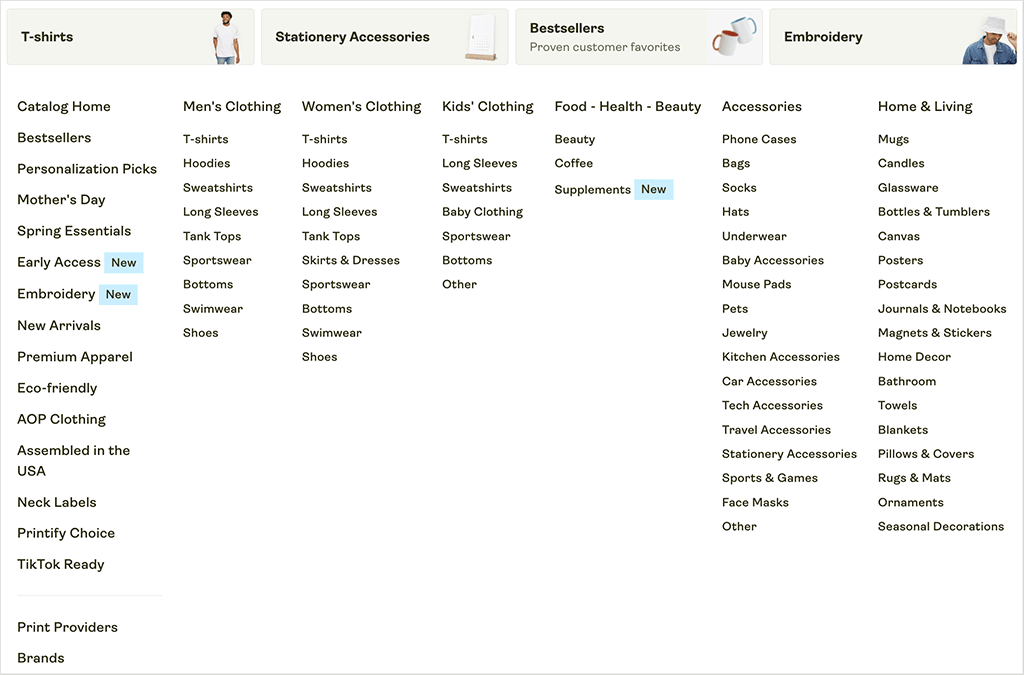
The same is true for hoodies. Printify’s catalog has over 50 hoodies on offer, double the number of hoodies you’ll find in both SPOD and Printful.
Examples of products you can source from Printify but not from any of its competitors include:
- neck ties
- car accessories (floor mats, seat protectors, etc.)
- jewelry (necklaces, bracelets, customizable jewelry boxes)
- oven gloves
- lunch bags and boxes.
So whether you want to sell an extensive range of product types, or would like to apply your designs to particularly niche items, you’re likely to find plenty of ways to do both in Printify.
Printify suppliers
As discussed above works with around 80 different print providers across more than 100 locations around the world.
(Around 50 of these print companies are based in the United States.)
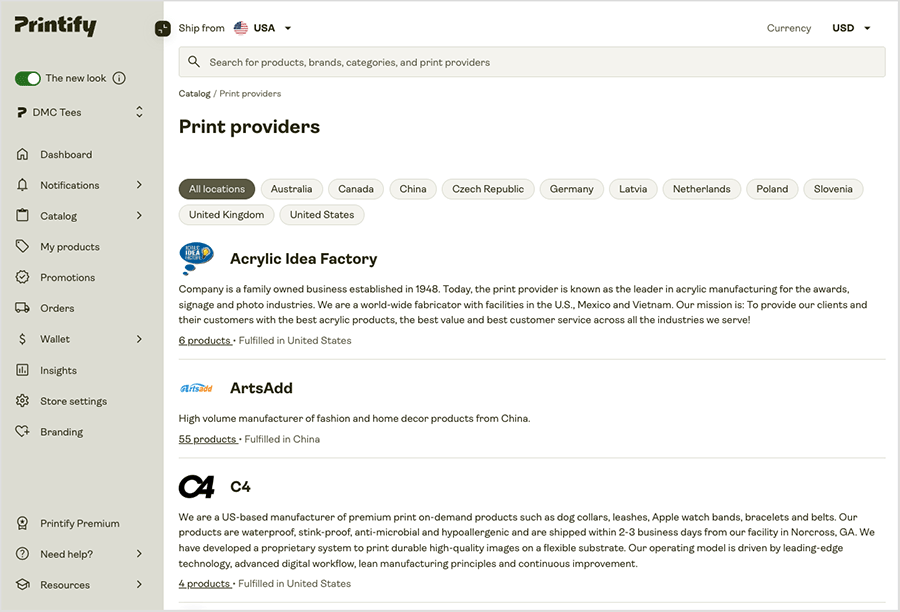
Choosing your print provider is done on a product-by-product basis. This means you can use one printer for a particular t-shirt product, another for a custom hat, another for a bag product and so on.
To help you choose the best one for your store, Printify’s product listings provide you with key information on the differences between each print provider’s fulfillment specifications (see screenshot below).

Depending on the product in question, you can compare print providers based on:
- supplier rating
- branding techniques
- location
- product prices
- shipping rates
- average production time
- product print areas
- available product sizes
- available product colors.
While all these factors are important when choosing a print provider for your product, one that’s worth paying particular attention to is Printify’s supplier rating.

This rating is an internal (and regularly updated) Printify score based on product quality, production speed and feedback from sample orders.
By choosing a print provider with a high score — ideally one with a 9+ star rating — you’re giving yourself the best chance of keeping your customers happy.

Something else that’s worth watching out for in Printify involves product print areas. Some Printify print providers can only print on one area of a product — for example, the front of a t-shirt. So, if you need to print on multiple areas, it’s important to check that your chosen supplier can facilitate this.
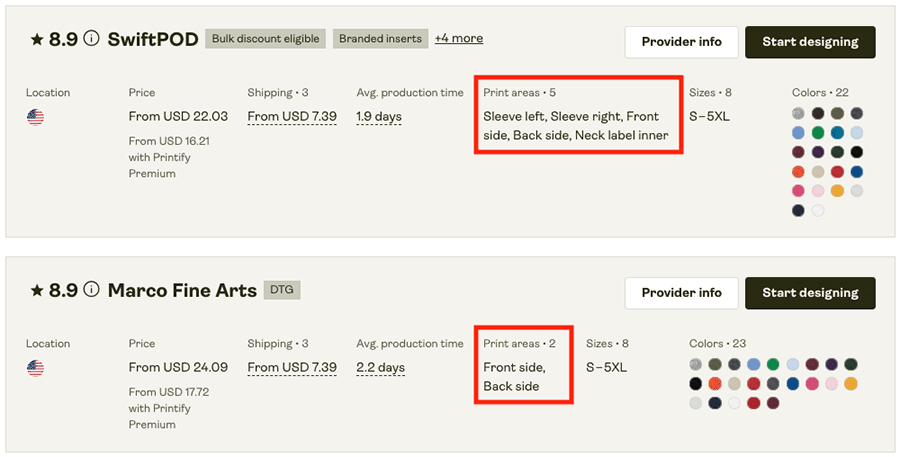
(On the plus side, Printify is currently in the process of standardizing product print areas across its full network of suppliers — so this hopefully won’t be a problem for too much longer).
To help users avoid some of the guesswork involved in picking a supplier, Printify has introduced something called ‘Printify Choice’. This is a curated selection of print providers who meet higher standards for production speed, quality, and overall reliability — essentially, Printify’s attempt to offer a more consistent, high-quality fulfillment experience.
‘Printify Choice’ products are marked clearly in the catalog and tend to ship faster, with more reliable stock levels and better branding options.
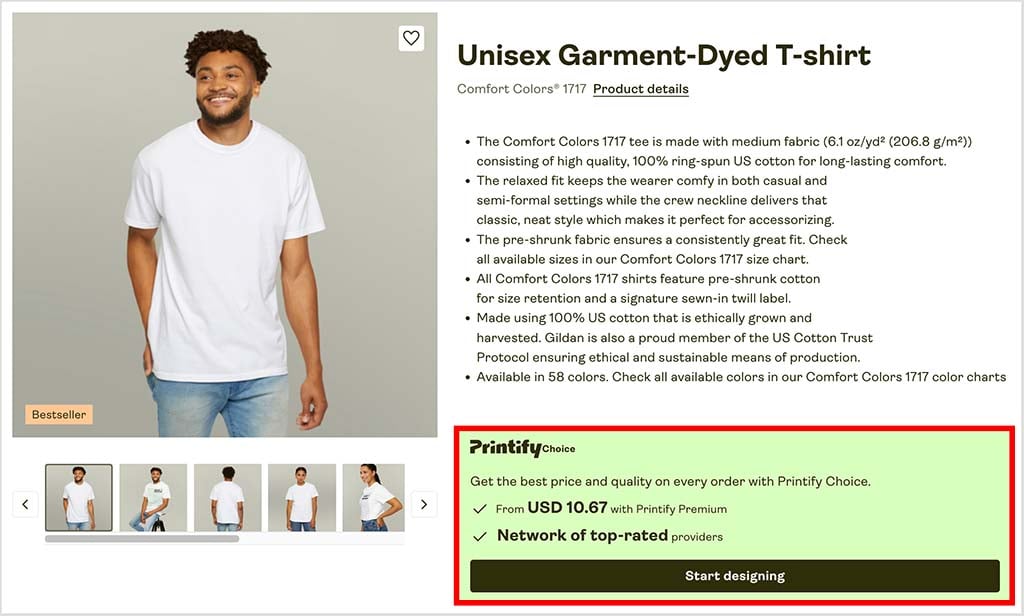
That said, while ‘Printify Choice’ is a nice idea in theory, I’m not entirely sold on it. For one, it doesn’t always cover the full range of products available on the platform — so you may still find yourself mixing Choice and non-Choice suppliers in your store. And second, filtering by Printify Choice doesn’t always mean you’re getting the best price or print area flexibility — so it still pays to do your homework.
Ultimately, Printify’s large network of suppliers is something of a double-edged sword for POD merchants. On one hand, it offers impressive flexibility and a vast product range — and for experienced sellers who don’t mind digging into all the pricing, print area specs, and shipping options, that level of control can be a real plus.
On the other hand, the sheer number of variables involved — from choosing the right supplier to understanding their fulfillment quirks — can be a bit much, especially for POD newcomers. ‘Printify Choice’ does go some way toward simplifying things by highlighting more reliable print partners, but it doesn’t eliminate the need for research. In many cases, you’ll still need to weigh up trade-offs between price, print area availability and product range — even within the Choice selection.
Printify’s order routing option
Printify’s ‘order routing’ is an interesting optional feature that can help you fulfill orders on your store when your chosen print provider is out of stock of your product (or experiencing production delays).
When you enable this feature in your Printify account, it automatically sends your order to an alternative print provider on the Printify network when your preferred printer cannot fulfill it.
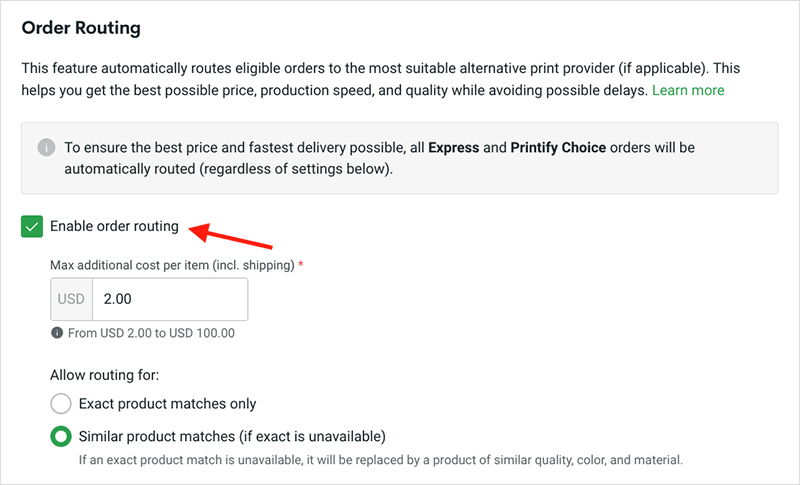
This can also be useful for selling POD products internationally, because it automatically routes international orders to print providers located in the same geographic region as your customer. This results in cheaper shipping and faster delivery.
But there are a couple of potential drawbacks to Printify’s order routing feature to consider.
First, it may result in some variation in the print quality of your product, since your order can be sent to a printer with different printing machines or a worse supplier rating than your default provider.
Additionally, on international orders, the order routing feature only works with single product orders — so, if an international customer orders several products from your store in one go, you won’t be able to reroute their order to the most convenient print locations.
These drawbacks aside, this feature is superb and lets you make the most of Printify’s large network of print providers.
You can learn more about Printify’s order routing option in the video below.
Print quality
According to Printify, all of its products are subjected to three rigorous quality checks. These are:
- an inspection of the ‘blank’ product when it arrives in a Printify print location
- consistent monitoring of printed products across all Printify print providers
- benchmarking of Printify products against equivalent products produced by other POD platforms.
When monitoring for quality, Printify enforces standards relating to image scaling, color profile, product durability and packaging quality.
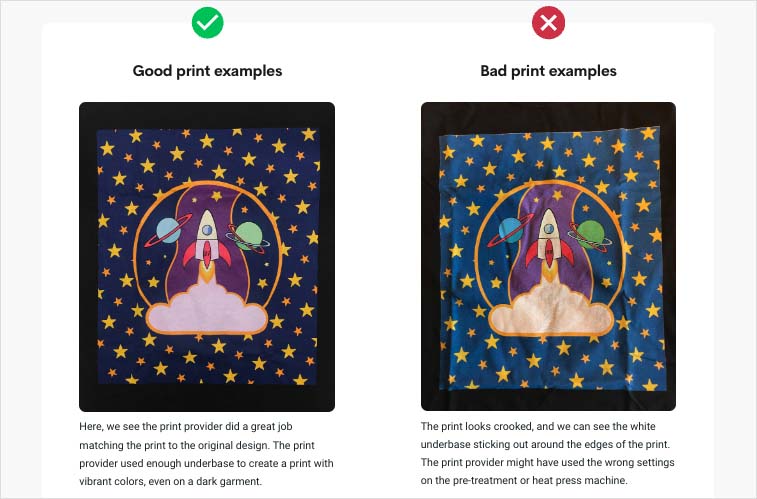
On the whole, Printify customers are very happy with print quality from the company, as indicated by app store scores of 4.8 out of 5 in Shopify and 4.5 out of 5 in Wix. However, based on my examination of user reviews on the above two ecommerce platforms, it seems that complaints about print quality problems seem to be slightly more frequent among Printify users than those of its competitors.
(To be fair, this is perhaps to be expected given the scale of Printify’s global network of printers.)
And in situations where your customer isn’t happy with a printed product, you can contact Printify within 30 days of the product delivery with photo or video evidence of the quality issue — Printify will then investigate the case and issue a free reprint where its printer is deemed not to have met the platform’s quality standards.
But as is the case with all POD suppliers, the best way to find out about print quality for your designs is to order samples and make sure they meet your standards. You can order these easily in your Printify dashboard.
(Unfortunately, no special discounts are applied on sample orders in Printify, however — some other POD apps, including its key rival Printful, offer these.)
Designing products
Creating custom products in Printify is very easy. The platform comes with a user-friendly product design tool — its recently upgraded ‘product creator’ — that lets you upload your own artwork, add text and format your design using a drag and drop editor.

The designer lets you upload JPEG, PNG and SVG files to your designs easily enough. You can simply drop them onto your project from your computer, or import them directly from cloud storage services (direct integrations with Google Drive and Dropbox are provided).
A key thing to note about Printify’s latest product designer however is that it’s a bit limited when it comes to text formatting. Although it gives you around 250 fonts to work with, it doesn’t let you apply basic effects like italics, bold or underline styles to them. Significantly, it’s not possible to upload your own fonts to Printify either (making it harder to align your product designs to your brand).
So I feel there is definitely some room for improvement on the text front.
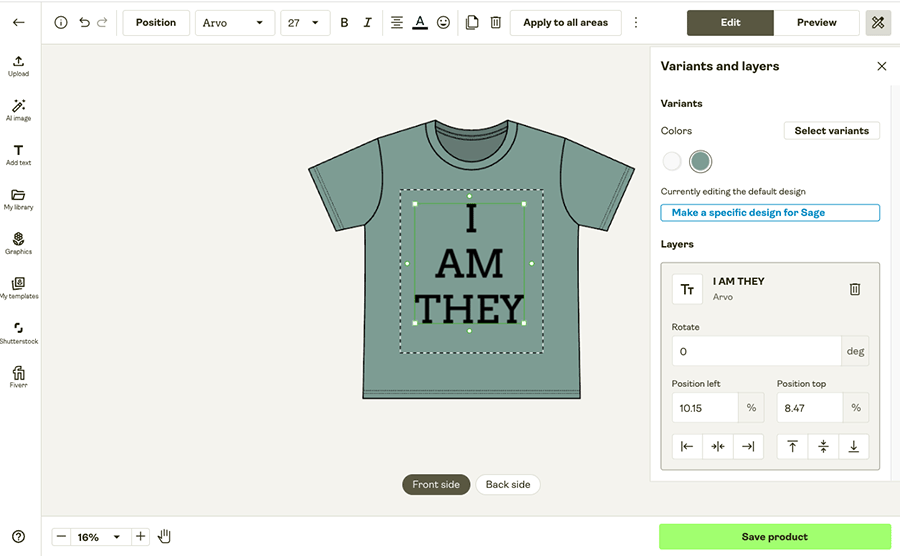
As for stock assets, the designer features a free graphics library as well as a huge range of 300+ million paid-for stock assets from Shutterstock. (With Shutterstock, you’ll be charged between $0.99 to $1.49 every time you sell an item featuring one of the company’s images.)
Printify also supplies a background removal tool. You can use this to erase photo backgrounds and foreground the main subject of the image in your designs. This works great — but frustratingly, can only be used three times per day (meaning that if you need to do a lot of background removal, you may need to resort to a third-party design tool like Canva or Photoshop).
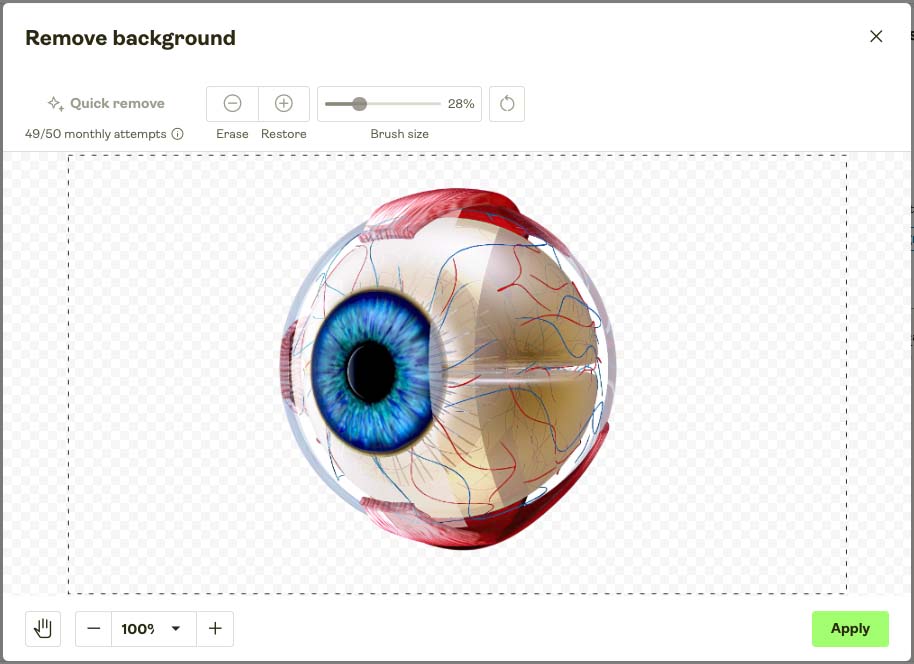
An interesting feature I found in Printify’s product designer but not in those of competing platforms is an AI image generator. This tool — based on ‘Stable Diffusion’ AI image software — can be used to generate original imagery for your product designs in a wide range of artistic styles (photos, digital art, anime, origami, 3D models, line art, etc.).
When testing this feature, I was pleased with the results — and would be happy to use them in product designs. (You can see some output examples for my prompt of “a man standing in a bamboo forest at night” below.)

The AI image generator produces 4 image options for every prompt, and you can use it 15 times per day in total.
All in all, Printify’s product designer is very good. I’d like to see better text formatting options and more generous limits for the background removal tool introduced, but on the whole, it’s very easy to use and includes features that you won’t find in several key competing POD platforms.
Product mockups
In the competitive world of print-on-demand and ecommerce, eye-catching product mockups can really help your products and store stand out from the crowd. So how good is Printify for creating these?
Well, in short, it’s ok but could be better.
On the plus side, Printify lets you access a decent range of product mockups for most items in its catalog. These display your design using a nice set of simple product shots and on human models too.
Selecting the mockups you want to use in your store is really straightforward. You just click the ‘Add view’ button under the mockups you want to use when you’re creating your product.
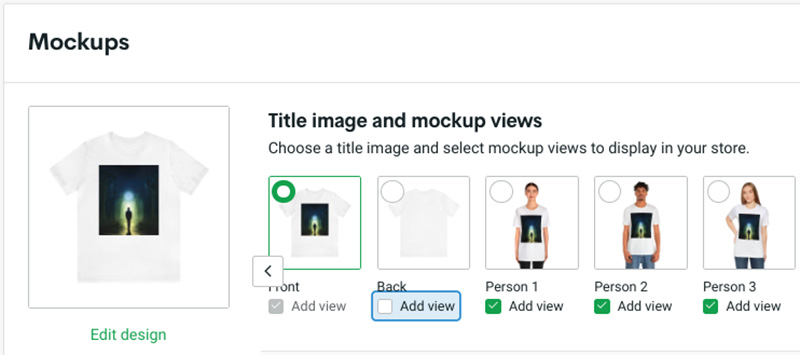
However, as you can see from the screenshot above, Printify’s default mockups mostly let you make use of a plain white background. If you want more colorful or varied product mockup backgrounds, you’ll have to source these outside of Printify and import them into the platform.
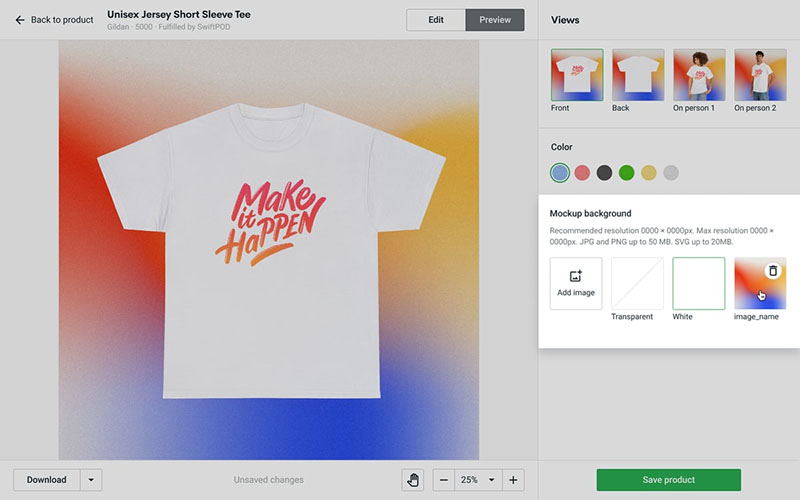
It would be so much better for Printify users if the platform provided a built-in library of editable mockup backgrounds.
(To provide a bit of context, rival POD platform Printful gives its users 2,550+ mockup backgrounds as standard.)
Branding options and packaging
When it comes to adding your brand to your Printify products, the platform lets you add neck labels to the inside of around 25 of its bestselling clothing items.
Again, this compares quite poorly with key competitor Printful, which caters for neck labels, outside labels and sleeve labels — all of which are available across a much bigger selection of its product catalog.
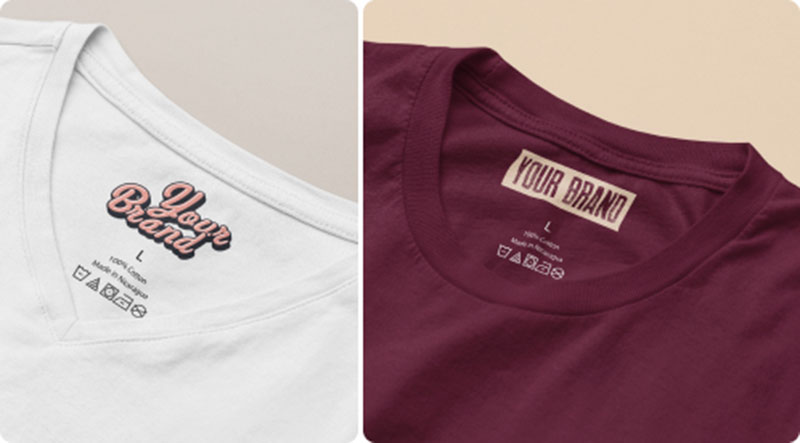
On the plus side, pricing for adding neck labels in Printify can work out cheaper than the equivalent fees charged by its competitors — $0.44 to $2.99 depending on the print provider in question.
(For reference, Printful always charges $2.49 for a single neck print.)
At time of writing, the Printify print providers offering this service are:
- Dimona Tee — from $0.55 per label
- SwiftPOD — from $0.68 per label
- Monster Digital — from $0.68 per label
- Stoked On Printing — from $1.71 per label
- Print Clever — from $1.62 per label
- Textildruck Europa — from $2.25 per label
- Ink Blot — from $2.99 per label.
As for packaging, all Printify products are packed in high-quality ‘white label’ mailers, boxes, packing tubes and so on — but, unfortunately, it’s not possible to add your own brand to this outer packaging in any way.
You can, however, add a branded packaging insert to your Printify order. This option is available from six of Printify’s print providers — generally highly rated ones — all of which charge $0.15 per insert. (This is $0.35 cheaper than the equivalent service offered by competing platform Printful.)
If you want to add any of these branding options to your Printify products, you can use the filters provided in the Printify product catalog (pictured below) to ensure that you select a product from a print supplier that offers them.

Overall, Printify gets a thumbs up for its branding options, with the caveat that it would be good to see them available across its whole catalog of products.
Printify environmental standards
Aside from its logo, just how green is Printify?
Well, as is the case with all print-on-demand platforms, Printify only prints your products after it receives an order from your online store. So, unlike large clothing brands, Printify doesn’t produce a large excess of textile and other products that remain unsold and go directly to landfill.
In terms of the environmental-friendliness of the products in Printify’s catalog, there’s a decent selection around 60 ‘eco-friendly’ products available (along with a filter to help you locate them).
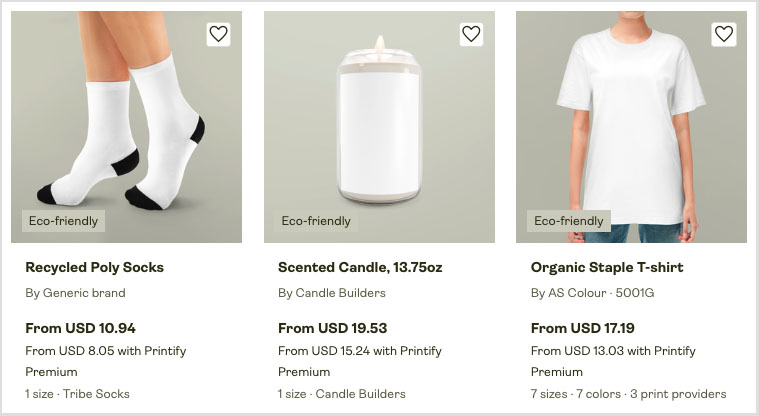
These include organic cotton products from PETA-certified manufacturer Stanly Stella, biodegradable ornaments and phone cases, as well as vegan-friendly candles and reusable travel mugs and water bottles.
Printify has also stated that it plans on becoming a ‘carbon-neutral’ company by 2030, and has signed up to the Tech Green Pledge to demonstrate its commitment to do so.
However, it would be good to see Printify take a leaf out of competing platform Printful’s environmental playbook, and actually publish annual figures for product recycling, fabric repurposing and (carbon-saving) local order fulfillment targets.
Shipping products
Printify and its network of print providers offer a good range of shipping options to get your products to your customers. The available shipping methods are as follows:
- Economy shipping — delivery to the US in 4-8 days, from $3.99. Available for Etsy, Shopify and Printify Pop-Up Store merchants only.
- Standard shipping — with pricing and delivery time dependent on individual print providers. Available for all Printify products and sales channels.
- Priority shipping — delivery in 2-3 days after production for US orders; within 3-5 days for international orders. Available for Shopify and WooCommerce customers only.
- Express shipping — where products are produced and delivered within 2-3 days. Available for Etsy, Shopify and Printify Pop-Up Stores .
Pricing for Printify’s primary shipping method — ‘standard shipping’ — depends on the print provider you have selected to produce your goods. Helpfully, Printify provides a detailed breakdown of each provider’s standard shipping costs on its shipping rates page.
Now, it’s important to note that although Printify shipping costs are generally in line with those of competing POD platforms, my research indicated that there can be a lot of variation in shipping costs for the same product across different Printify print providers.
Take a look at the table below to see the cost of shipping the popular Bella + Canvas 3001 t-shirt with the top five Printify print providers:
| Printify print provider | Cost of shipping 1 t-shirt |
| Monster Digital (9.3*) | $3.99 |
| Drive Fulfillment (8.7*) | $5.19 |
| Print Geek (9.3*) | $9.59 |
| Shirt Monkey (9.3*) | $13.99 |
| Opt OnDemand (9.2*) | $12.49 |
As you can see, there can be quite a difference in shipping costs depending on your chosen print provider.
This demonstrates the importance of carefully comparing each print provider when selecting one as your supplier — it’s essential to pick one that can not only produce your product the way you want, but also provide good value to your customers when it comes to the cost of shipping.
As for Printify’s ‘express shipping’ option, this is currently available for just two t-shirts at the moment (but will be available for more products soon). And merchants using it should note that it automatically routes orders to the print provider nearest to your customer — something that may have print quality implications.
If you use Printify to sell on Shopify, you can display real-time shipping rates for Printify products by adding the ‘Printify Shipping Calculator for Shopify’ to your store.
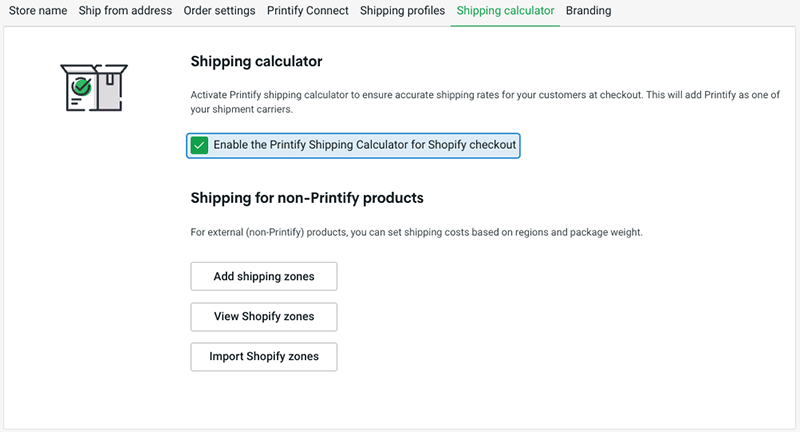
The bottom line on Printify shipping options is that they are pretty flexible, and so long as you shop around, you can find good rates from many of Printify’s printing partners.
You can learn more about Printify shipping options and fees here.
Integrations with ecommerce platforms and marketplaces
Printify offers a good range of integrations with ecommerce platforms and online marketplaces. A total of 11 direct integrations is available, including with Shopify, BigCommerce, Squarespace, Wix, eBay, Amazon and Etsy.
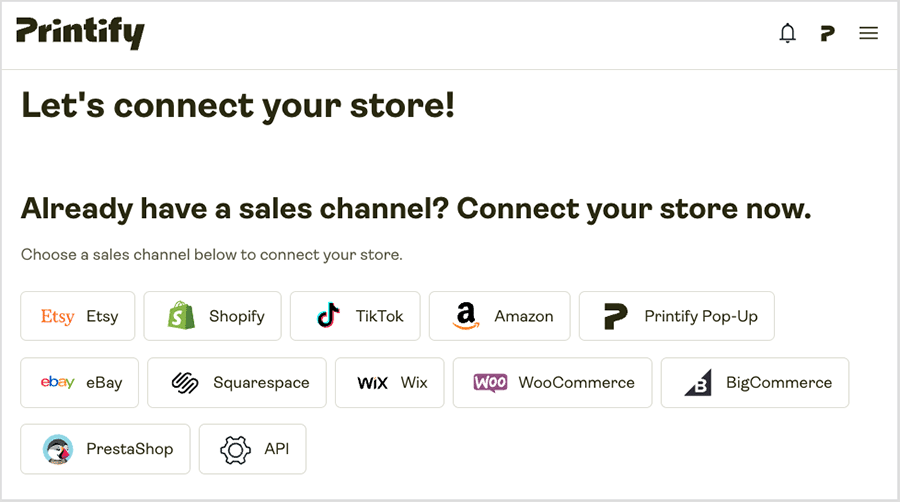
Printify’s range of integrations is considerably larger than those provided by several competing POD platforms — for context, Gooten offers just 4, SPOD offers 5 and Spring (formerly Teespring) lets you use 6. Printful, however, works with 23 platforms (and significantly, Amazon too, which Printify doesn’t yet offer a built-in integration for).
The full list of Printify integrations is as follows:
- Etsy
- Shopify
- TikTok
- Walmart
- eBay
- Squarespace
- Wix
- WooCommerce
- BigCommerce
- Prestashop
Setting these up is straightforward enough, and based on their reviews, Printify users seem happy with how they work — the integrations are rated at 4.8 out of 5 in the Shopify app store, 4.5 in Wix’s and 4 in BigCommerce’s.
WooCommerce users are less satisfied however, only giving the ‘Printify for WooCommerce’ integration a 2.9 out of 5 rating in the WordPress plugin directory.
If you’re selling Printify products via the Etsy integration, it’s worth highlighting that you can take advantage of a handy extra: automated product personalization. This lets your customers add custom text—like names or dates—directly to your designs, making it easy to offer personalized items without the manual back-and-forth. You can also give buyers the option to include a custom gift message, which will be printed on a branded postcard and included with their order. Both features help add a personal touch to your products while keeping the process streamlined on your end.
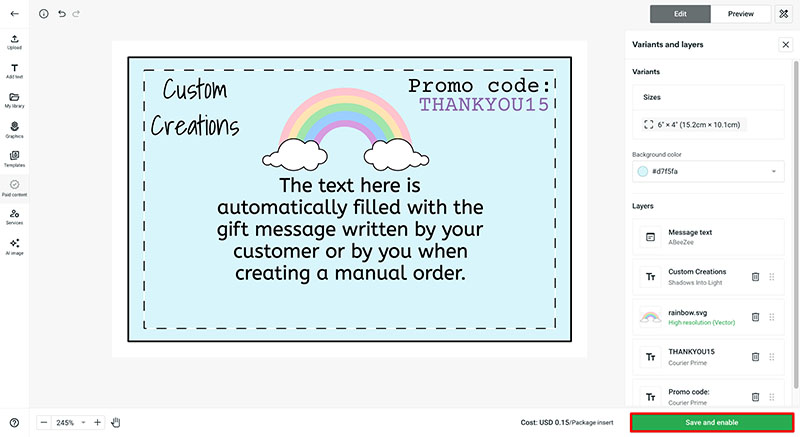
If an integration with your own ecommerce platform isn’t available from Printify yet, you may be able to use Printify’s Application Programming Interface (API) to create your own connection with it — doing so won’t involve any costs, but you’ll need development skills.
Another option is to consider using a third-party service like the ‘Order Desk’ automation tool to integrate Printify with other services. This opens up the possibility of connecting Printify to hundreds of ecommerce platforms and marketplaces (including Amazon, Costco, Square, Webflow and Wish). But it’s important to note that monthly fees apply for using the service, as well as transaction fees (ranging from $0.05 to $0.25) being applied to every sale you make.
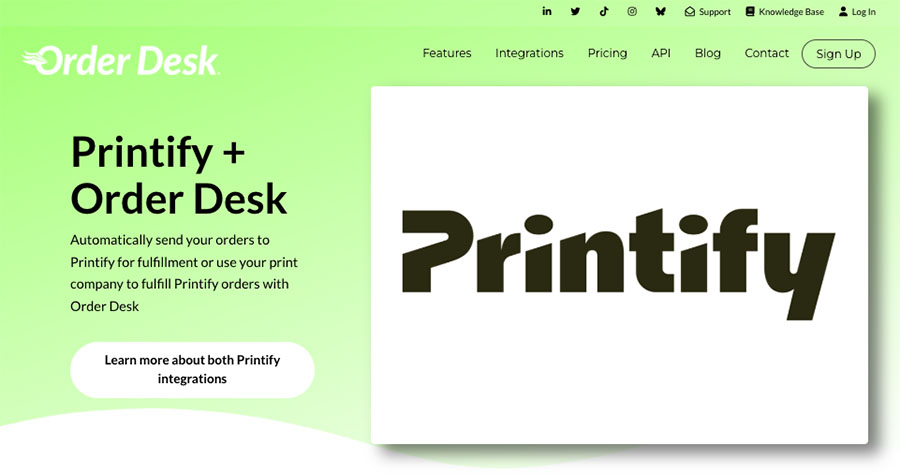
Pop-up store feature
A unique feature that you get in Printify but not in most competing POD platforms comes in the form of its ‘Pop-Up Store‘ builder.
This lets you create a simple ecommerce storefront in Printify itself — i.e., without needing to involve an online store builder tool.
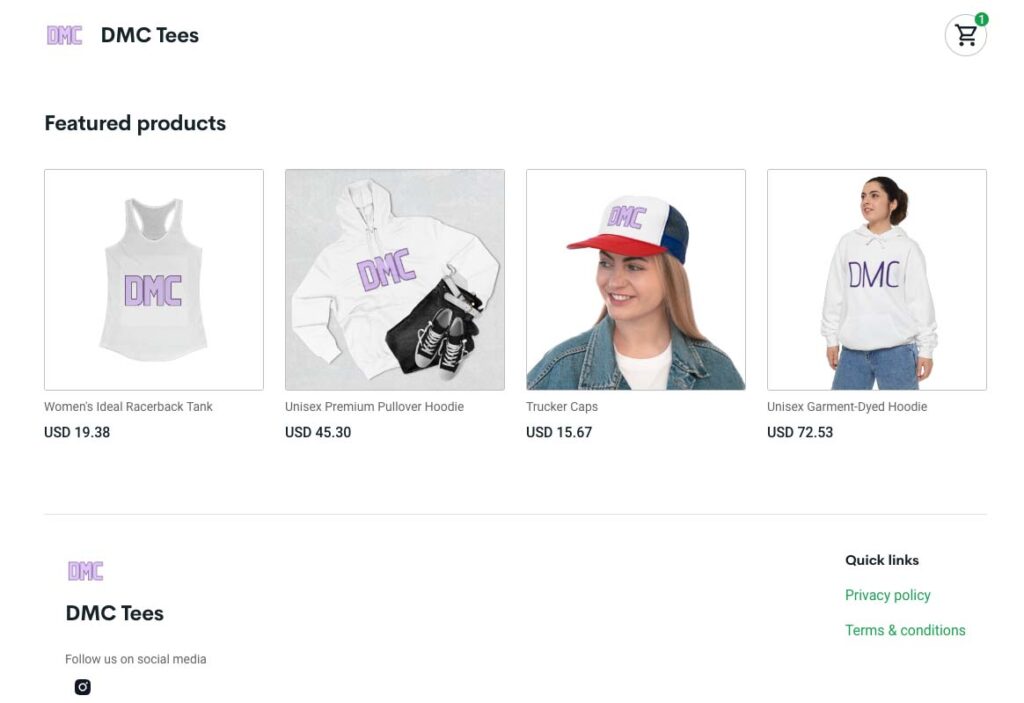
Now, compared to the more sophisticated online storefronts that can be developed with services like Shopify or Wix, Printify’s Pop-Up Stores offer pretty basic functionality.
The customization options are minimal — offering little beyond the ability to upload a brand logo — and there are just a handful of color scheme templates to choose from.
Additionally, these pop-up stores don’t support the use of a custom domain name; you’ll have to make do with a ‘mystorename.printify.me’ URL format instead.
But the Popup Store builder does make the process of launching a basic POD store extremely quick, and without there being any transaction fees to worry about. Additionally, it’s possible to add Google Analytics and Facebook pixels to Printify Popup Stores — which adds considerably to their usability.
So, while not being a substitute for a fully-fledged online store, Printify Popup Stores definitely have their uses. Sellers operating on a tight budget, or those who rely on social media rather than web traffic for sales, may well love them.
Interface and ease of use
The Printify interface is well-organized and loads quickly — it provides easy access to key print-on-demand tasks like product design, store addition, order management and store settings.
On the left-hand side of the interface, you use a traditional navigation menu to access key tools and settings (these are then displayed on the right-hand side of the screen).
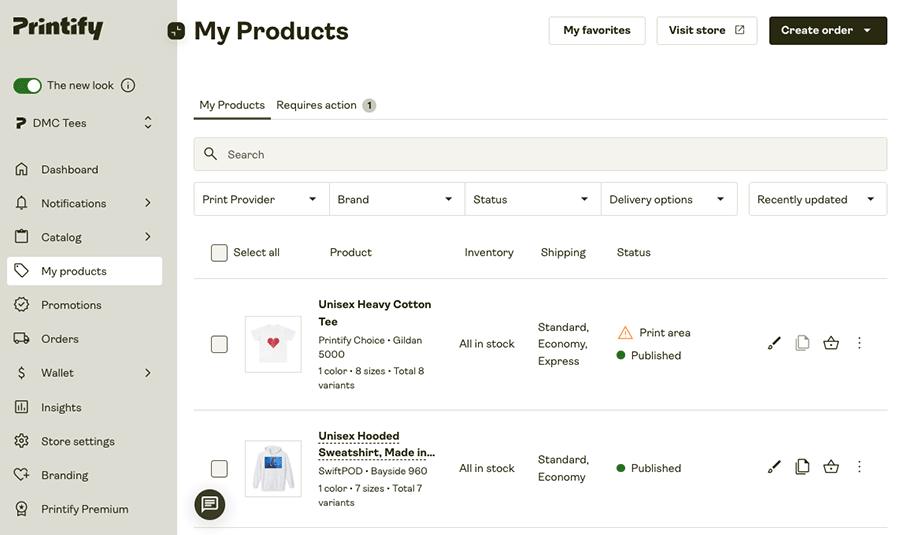
I found Printify’s product catalog very easy to navigate: the platform gives you access to a comprehensive filtering system, which lets you sift through products based on target markets, product features, shipping options, product price and more.
As discussed earlier, designing products in Printify is also very straightforward, and the platforms ‘product creator’ design tool includes several unique features — for example, an AI image generator and a product preview option — that you won’t find in competing POD platforms.
Printify’s order routing tool — which automatically sends your orders to printers near your customer so that orders get delivered as quickly as possible — represents another big plus in the ease-of-use department. It unburdens POD merchants from having to manually reroute products to alternative print providers and helps simplify international selling.
So I would say that Printify comes very close to full marks when it comes to ease-of-use.
Handling customer queries with ‘Printify Connect’
If you pay for a Printify plan, you can avail of the ‘Printify Connect’ service. This lets you outsource your customer queries to Printify’s support team.
On paper, this sounds great — a way to do away with time-consuming customer support requests. But in practice, I found that using Printify Connect doesn’t mean you can avoid all dealings with customers.
In cases where a customer requests a reprint of an item, Printify will make a decision on this — but leaves it to the merchant to let the customer know if a reprint has been approved or not. This undermines the feature’s usefulness, in my view.
Nonetheless, being able to outsource other types of customer enquiries will be music to the ears of many POD sellers.
It’s worth noting that Printify Connect is only available for standalone stores using ecommerce platforms like Shopify, Wix and WooCommere; it can’t be used in conjunction with online marketplaces (Amazon, Etsy, etc.).
Mobile apps
Printify comes with a mobile app for managing your account on the go — but only for Android users. Released in 2023, the app is still in early-access Beta testing, so there isn’t a star rating available for it just yet. But so far, it has been downloaded more than 500k times from the Google Play Store (including by me!).
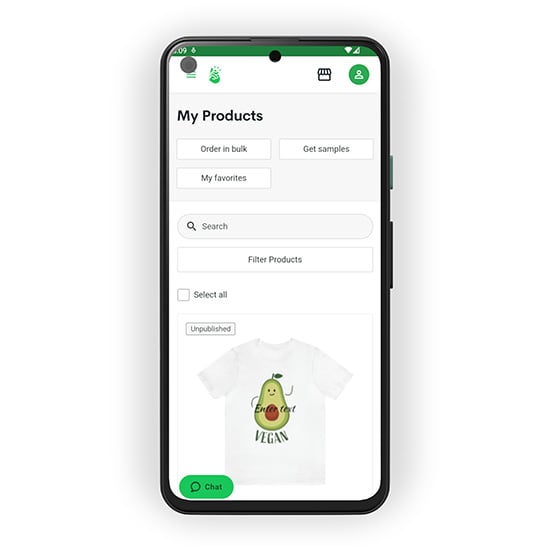
While using the app, I found it gave me comprehensive access to all the key features I needed. All the main design and store management features are present in it, and designing products ‘in app’ is almost as easy as doing so on a full-sized computer monitor.
So it’s a thumbs up for Printify’s app from this Android user — but hopefully we’ll see an iOS version made available soon too.
The Printify experts program
Printify offers merchants the ability to outsource some aspects of running their POD businesses to industry specialists via its ‘Printify Experts’ program.
This lets you get help from a wide range of certified graphic designers, digital marketers and ecommerce experts — these specialists will handle store management tasks that you can’t complete due to a lack of skills or time.
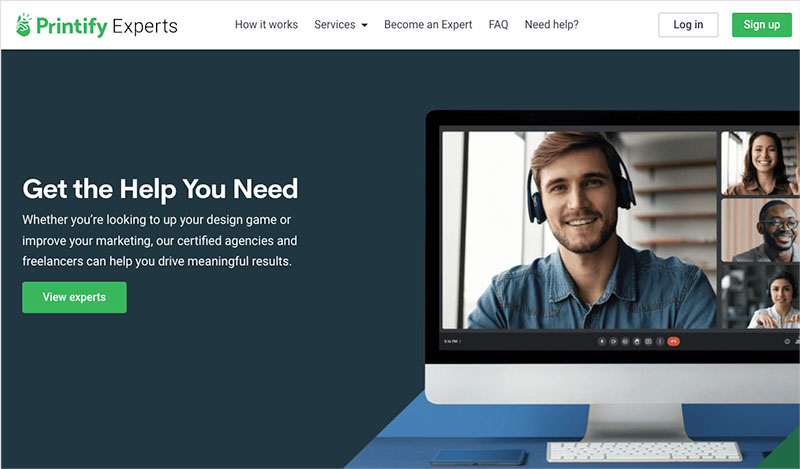
The program features detailed profile pages for each expert, giving you access to their past work, user reviews and service fees.
Fees charged by Printify experts can range from $35 per hour on bespoke design tasks, to as much as $2,200 for a single logo.
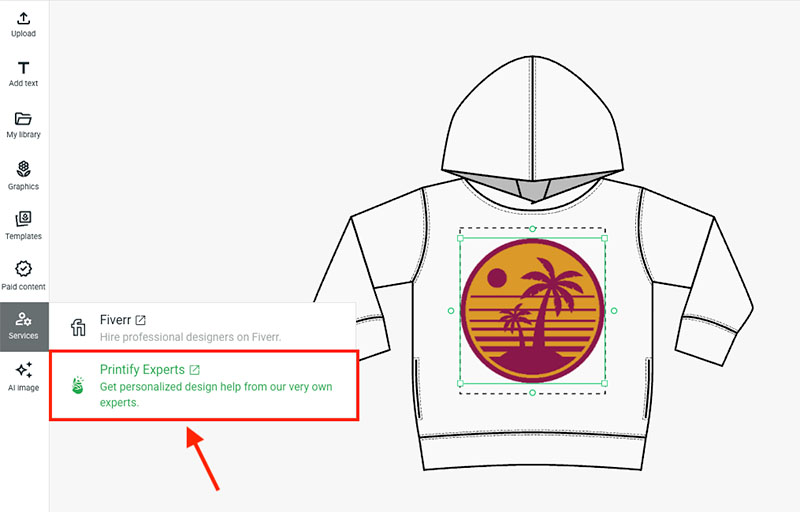
Printify pricing and value for money
Printify plans
There are three Printify pricing plans available:
- Printify Free — $0 per month
- Printify Premium — $29 per month
- Printify Enterprise — custom pricing
The free plan gives you access to all of Printify’s store management and product design tools, but limits you to creating a maximum of 5 stores on your account.
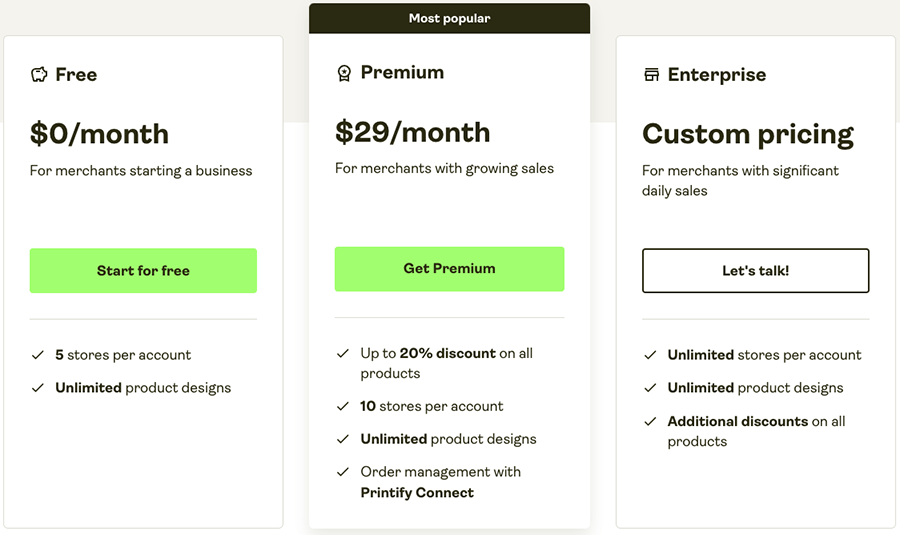
Free plan users can create an unlimited number of products — but these are charged at Printify’s standard product prices.
The next plan up is Printify’s $29 per month ‘Premium‘ plan. This lets you create up to 10 stores and also gives you access to discounted pricing of up to 20% on all Printify products.
You can save 14% on the ‘Premium’ plan if you pay for your plan on an annual basis. This effectively brings your monthly fee down to $24.99 per month.
The ‘Premium’ plan also includes the optional ‘Printify Connect’ customer management service, which lets you outsource your customer order queries to Printify.
Finally, there’s Printify’s ‘Enterprise‘ plan, which is intended for larger POD businesses and lets you create an unlimited number of stores. Significantly, it gives you access to a dedicated account manager and lets you negotiate custom discounts on products in the Printify catalog.
But which plan represents the best value?
Well, if you’re entirely new to POD selling, the Printify free plan is a pretty good place to start. It lets you work with Printify’s full range of products and print suppliers. However, once your store is up and running and making a few sales, it usually makes more sense to start paying for the ‘Premium’ plan.
The discounts available on this plan arguably make Printify one of the cheapest POD platforms on the market. And, once you’re selling a handful of products a month, the savings from the ‘Premium’ plan discounts should easily cover your monthly subscription fees (and then some).
Now, let’s take a look at Printify’s product pricing.
Printify product pricing
Pricing for Printify products depends on your chosen print provider.
Here is a sample of Printify suppliers’ pricing for some of their bestselling POD products:
| Product | Lowest standard price | Highest standard price |
| Bella + Canvas 3001 t-shirt | $10.87 | $14.81 |
| Gildan 18500 hoodie | $22.03 | $25.08 |
| Gildan 18000 sweatshirt | $18.17 | $19.69 |
| Bella & Canvas 3200 baseball tee | $19.30 | $21.41 |
As you can see, there can be significant variations in pricing from one print provider to the next.
For example, selling the Bella + Canvas 3001 t-shirt with the cheapest supplier (Drive Fulfillment) will cost you $10.87 — but printing the exact same shirt with the dearest one (JAMS Designs) will cost you $14.81.
Another example of product pricing variation involves the Gildan 18500 hoodie — there’s a $3.05 difference in the prices charged by Printify’s cheapest and most expensive supplier. This equates to a significant 36% difference in the two suppliers’ pricing for the same product (which obviously has huge implications for how you decide on its eventual retail price).
Premium Printify users also need to be aware that print providers don’t offer the same discounted rates on individual products.
For example, the Print Clever supplier sells the Bella + Canvas t-shirt for $9.46 to premium Printify users — giving them a 13% discount on the standard price. But the Drive Fulfillment supplier offers discounted pricing on this t-shirt of around 20%.
If you’re thinking this is rather complicated, you’re right — it is. There is no getting away from the fact that using Printify to sell POD goods involves a lot more research and patience than doing so with competing platforms, and this for me is probably the biggest downside of the platform.
That said, if you put in the time, you can definitely leverage Printify’s more complex pricing options to your advantage — because many popular POD products can be found for less in Printify than in competing platforms.
The table below compares Printify’s cheapest prices for several popular POD products with the equivalent fees charged by key competitor Printful. As you can see, Printify provides the lower starting prices for 4 out of 5 products.
| Product | Printify lowest standard price | Printful standard price |
| Bella + Canvas 3001 t-shirt | $10.87 | $11.50 |
| Gildan 18500 hoodie | $22.03 | $18.95 |
| Champion hoodie | $34.33 | $35 |
| Stanley Stella STW032 t-shirt | $14.36 | $15.29 |
To be fair to Printful, its POD product pricing is much more competitive when compared against the fees charged by Printify’s highest-rated print providers. But nonetheless, if your primary focus is on maximizing profits on your POD store, you can technically do this more easily in Printify than with most competing platforms.
So the bottom line on Printify pricing and value for money is this: the platform offers some of the lowest prices around, but you will need to invest significant time in choosing print providers to ensure they deliver not just when it comes to price, but on print quality and fast shipping too.
Customer support
Printify offers you two 24/7 customer support channels — email and live chat.
I’ve generally found Printify’s live chat support to be pretty good, although I have encountered some congestion issues on occasion. These can result in delayed responses (see screenshot below).
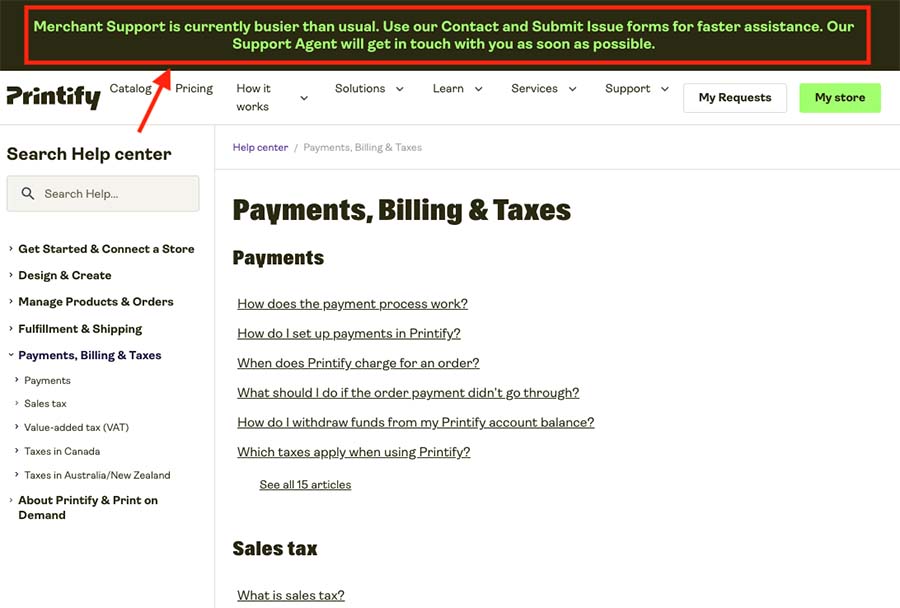
Printify also provides a comprehensive help center containing articles on all key aspects of running a POD business through the platform. The help center makes good use of video explainers and animated GIFs to demonstrate how to use the platform’s features.
Unfortunately however, these help center materials are only available in English — it would be nice to see a few more languages catered for.
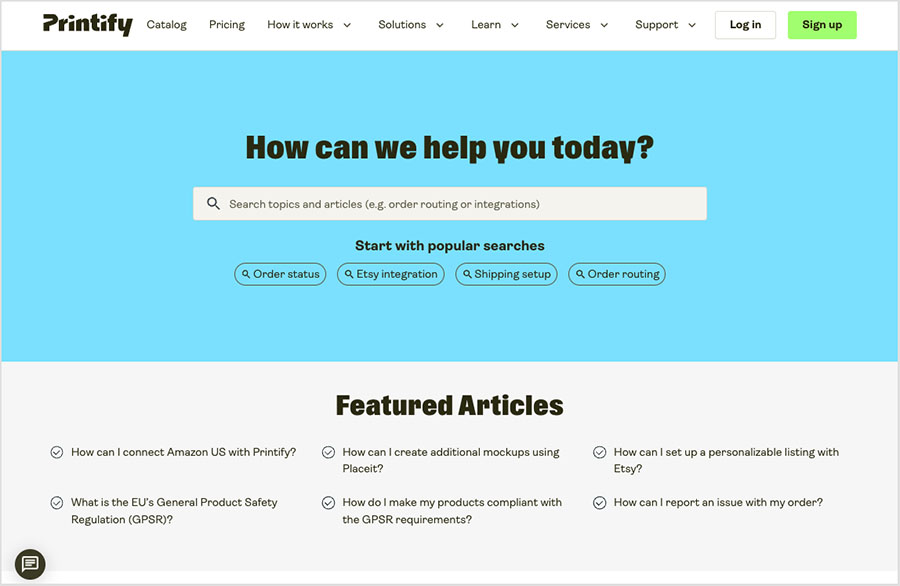
Finally, you can also take advantage of group mentoring sessions and training courses through the Printify ‘Sellers Club’ program. Led by experienced Printify sellers, these sessions are designed to help you grow your store with practical insights and real-world strategies. While some content is available for free, full access — including exclusive workshops, Q&As, and advanced courses — requires a monthly subscription of $4.99.
All in all, Printify support is pretty comprehensive. It offers a huge amount of content for new POD merchants to get stuck into — but I’d like to see this translated into more languages. Phone support would be good too.
Printify review: the verdict
Overall, Printify gives you all the key things you need to set up and launch a successful print-on-demand business. Its free plan lets you create an unlimited number of products from an impressive product catalog; and its reasonably-priced premium plan adds a lot of value to your POD business in the form of product discounts and extra store management features.
Thanks to its well-designed and speedy interface, the platform is very easy to use when it comes to product design and general POD store admin tasks (integrating with ecommerce platforms, setting profit margins, order management, etc.).
And Printify’s product prices offer good value when compared to those of key competing POD companies. You’ll find that its products are much cheaper than those made available on platforms like SPOD and Spring, and competitively priced against those of its main rival, Printful.
That said, I feel there is room for improvement, particularly so where product branding is concerned. The number of ‘brandable’ products could be significantly increased, and I’d like to see an option to use branded outer packaging added too.
And it’s worth mentioning again that Printify requires POD sellers to do a lot of homework to get the best prices when selecting print suppliers. This is not necessarily a bad thing, because of the low product pricing that can be accessed through this process. But some users may be put off by the workload involved and nudged in the direction of competing POD solutions.
Of course, the best way to find out if Printify is for you is to try the platform out yourself — you can get a free Printify account here.
I’ll wrap things up with my summary of the key pros and cons of Printify — do leave a comment if you have any thoughts or questions of your own.
Printify pros and cons
Reasons I’d use Printify
- With 1,000+ customizable products on offer, Printify gives you access to one of the biggest POD product ranges on the market.
- You can choose from 80+ print suppliers based on location, price, production time, shipping cost and supplier ratings. This gives you a lot more say over the order fulfillment process than most competing platforms do.
- You can create a simple standalone online store using Printify.
- Its free plan gives you a low-risk way to start selling custom designs.
- It’s easy to use.
- Product pricing is very competitive, as are the discounts on the Printify premium plan.
- Its ‘order routing’ tool ensures you can get products to international customers quickly and cheaply.
- Printify lets you outsource your customer order queries via the ‘Printify Connect’ program.
- Printify’s product designer includes a good AI image generator tool.
👉 Free Printify Plan: start using Printify for free here
Reasons I’d avoid Printify
- It takes longer to choose products in Printify than other platforms due to its large supplier network and the variability in pricing between suppliers.
- Printify is lacking built-in integrations with some important ecommerce platforms and marketplaces like Ecwid, Big Cartel, Webflow, Walmart and Amazon.
- Its product designer could be better, especially where fonts and text editing are concerned.
- You can only add product labels to a small portion of products in Printify’s catalog.
- There is no iOS mobile app available for Printify.
- Product print areas are not standardized across all Printify suppliers yet.
- Other platforms let you upload larger artwork files.
👉 Free Printify Plan: start using Printify for free here
Printify alternatives
When it comes to creating a print-on-demand store, there are quite a few alternatives to Printify available. Here’s a quick look at some of the top ones.
Printful
Printful is probably the strongest alternative to Printify. Unlike Printify, Printful handles all the printing and fulfillment of your POD products in its own network of in-house print facilities — meaning that print quality is more controlled and consistent.
You can try the platform out here.
Additionally, the platform integrates with a wider range of ecommerce platform and marketplace integrations than Printify; comes with a more powerful product designer; and gives you more options when it comes to mockups and branding.
For more information on the product and how it stacks up against Printify, do check out our Printful review and our Printful vs Printify comparison.
Spring (formerly Teespring)
Spring is a print-on-demand company that caters mainly for social media content creators. It provides direct integrations for TikTok, Beacons, YouTube, Twitch, Linktree and OnlyFans — making it a particularly interesting POD solution for influencers and content creators.
You can learn more about this platform in our Printful vs Spring comparison.
SPOD
SPOD is a print-on-demand company that provides very fast production times. SPOD claims that around 95% of orders are printed and ready for shipping within 48 hours.
You can learn more about SPOD in our in-depth SPOD vs Printful comparison.
Canva
Another way to kick off a POD business is by using Canva, a versatile design app that supports the creation and printing of 45 printed product types.
Unlike the dedicated POD services mentioned above, Canva is a multi-purpose design tool that can be used for a huge range of design tasks — including creating complex designs that you can then upload to other POD platforms like Printify and Printful.
Canva’s design interface is far more powerful than those of most POD platforms, giving you access to a wider range of editing tools (brushes, photo-editors and more) along with a huge range of royalty-free stock images and graphics that you can add to your designs.
You can learn more about Canva in our full Canva review and our Canva Pro vs Free article.
Printify in numbers
| Year founded | 2015, Lavia |
| Products | 1.000+ |
| Number of print locations | 100+ |
| Value of processed orders | $500M+ |
| Number of users | 10+ million |
| Integrations | 11 |
| Standalone online store | Yes |
| Pricing | $0 – $29.99 per month |
| Number of stores per plan | 5 stores on free plan; 10 stores on premium plan |
| Branding options | Neck labels and packaging inserts |
| Shopify app store rating | 4.8 stars |
| TrustRadius rating | 4.8 stars |
| iOS app | No |
| Android app | Yes |
| Merchant support | 24/7 email and live chat |
| Custom API integration | Yes |
No comments